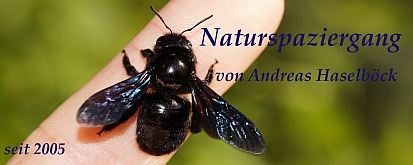Lebensweise:
Die
Breitfüssige Rosenerzwespe wird seltener gefunden als die
übrigen "Bewohner" der Gallen der Rosengallwespe
Diplolepis rosae. Die Art ist sowohl als Parasitoid als auch
als Hyperparasitoid im "System"
Rosengalle bekannt.
Nahrung: Imago: ? Larven: Parasitoid und Hyperparasitoid
in Rosengallen
Gefährdung und Schutz: Nicht gefährdet / Nicht unter Schutz gestellt
Anmerkungen:
Siehe:
An integrative approach to species discrimination in the
Eupelmus urozonus complex (Hymenoptera, Eupelmidae), with
the description of 11 new species from the Western Palaearctic
FADEL AL KHATIB, LUCIAN FUSU, ASTRID CRUAUD, GARY GIBSON,
NICOLAS BOROWIEC,
JEAN YVES RASPLUS, NICOLAS RIS, GÉRARD DELVARE; 2014
Abstract
The systematics of the European species of Eupelmus (Eupelmus)
Dalman (Hymenoptera: Eupelmidae) belonging to the ‘urozonus
complex’ is elucidated through combined molecular and
morphological characterization. One mitochondrial gene fragment
(Cytochrome oxidase I) and one nuclear protein‐coding gene
fragment (Wingless) were sequenced and the results compared with
those of a detailed morphological study of the specimens from an
extensive sampling. Knowledge of the biodiversity of Eupelmus in
the Western Palearctic Region is significantly improved through
the separation and description of 11 new species: E. (Eupelmus)
confusus Al khatib sp.n., E. gemellus Al khatib sp.n., E.
janstai Delvare & Gibson sp.n., E. longicalvus Al khatib & Fusu
sp.n., E. minozonus Delvare sp.n., E. opacus Delvare sp.n., E.
pistaciae Al khatib sp.n., E. priotoni Delvare sp.n., E.
purpuricollis Fusu & Al khatib sp.n., E. simizonus Al khatib
sp.n. and E. tremulae Delvare sp.n. Illustrated keys to females
and, when known, males of these new 11 species plus the other
already described species considered to belong to the ‘urozonus‐complex’
(E. acinellus Askew, E. annulatus Nees, E. azureus Ratzeburg, E.
cerris Förster, E. fulvipes Förster, E. kiefferi De Stefani, E.
martellii Masi, E. stenozonus Askew, E. tibicinis Bouček and E.
urozonus Dalman) are provided and all the species are described
based on morphology. Eupelmus kiefferi is removed from synonymy
under E. urozonus and E. azureus is recognized as the valid
senior synonym of Pteromalus cordairii Ratzeburg, 1844 and
Eupelmus spongipartus Förster, 1860 syn.n. The discrimination of
the species included in this complex is particularly relevant
because some are potential biological control agents and have
been confused in the past.

